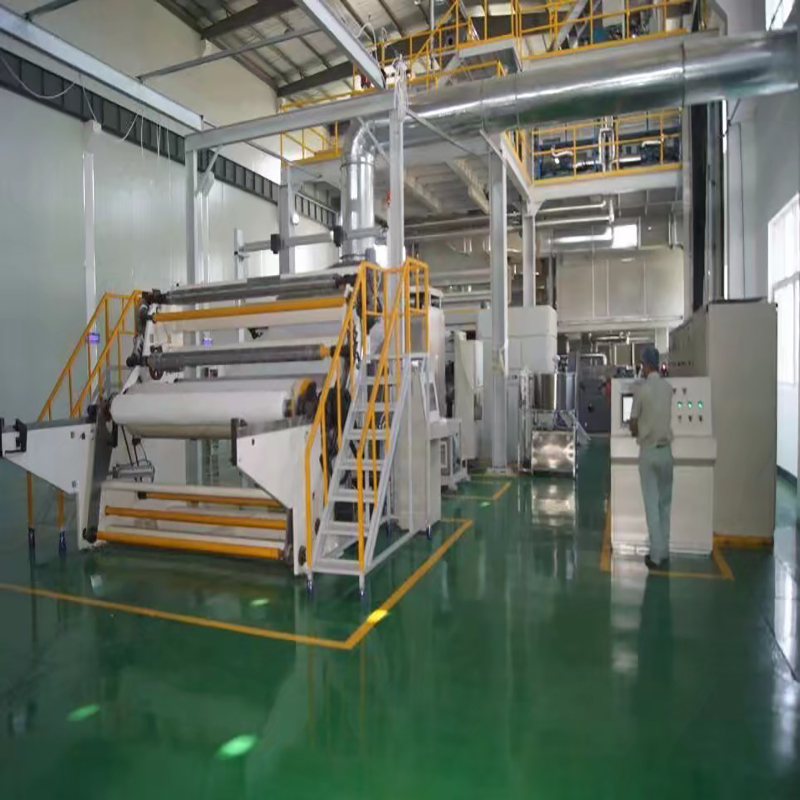Машина для производства нетканых материалов, используемая для производства различных нетканых материалов, включая гигиенические изделия., Фильтрационная среда, и ткани для одежды. Распространенным типом прядильных машин является полипропиленовый. (ПП) Одноступенчатая машина для выдувания сэндвичей из расплава и прядения из расплава (ССММС), который производит комбинированные полотна спанбонд и мелтблаун за один процесс.. Этот ПП SSMMS центрифугирующая машина предлагают высокую производительность и производительность для производителей нетканых материалов.

Расскажите о машине для прядения PP SSMMS.
В машине для прядения PP SSMMS., полимерные гранулы, такие как полипропилен, сначала загружаются в бункер и транспортируются в экструдер.. Внутри экструдера, полимеры расплавляются и прогоняются через фильеру. В фильере имеется множество крошечных отверстий, из которых на выходе образуются непрерывные полимерные нити..
Когда расплавленные нити выходят из фильеры, они вытягиваются вертикально с помощью годе-системы, где охлаждаются воздухом.. По мере затвердевания нитей, они становятся тоньше и стабильнее, образуя непрерывные волокна. Эти волокна затем проходят через зону сэндвича, где между слоями спанбонд впрыскивается горячий воздух для формирования слоя, полученного методом экструзии из расплава..
Зона сэндвича – ключевая особенность одноступенчатых станков SSMMS.. В этом разделе, волокна спанбонда проходят между верхним и нижним конвейером, с продувкой горячим воздухом из сопел между ними для создания слоя, выдутого из расплава. Количество горячего воздуха, Давление воздуха и расположение сопел определяют основной вес и толщину слоя мелтблауна..
После сэндвича, Комбинированное полотно, состоящее из слоев спанбонда и слоев, полученных выдуванием из расплава, проходит через роликовый станок и в печь для отжига и дальнейшего охлаждения.. Отожженная композитная сеть затем наматывается на ролику.
К ключевым преимуществам машин ПП ССММС относятся:
- Высокие темпы производства – До 800 кг/час нетканого материала можно производить.
- Гибкость ширины – Ширина полотна от 1.2 к 4.5 метры возможны, в зависимости от машины.
- Улучшенный контроль соотношения слоев – Соотношение спанбонда и слоев мелтблауна
можно точно установить из 20/80 к 80/20. - Равномерный вес полотна – Точный контроль вращения, поток воздуха и намотка обеспечивают постоянство
базовые веса в пределах +/- 3%. - Превосходное качество и производительность – Интегрированный процесс производит композитные полотна с
соединение между слоями для повышения прочности, барьерные свойства и фильтрация.
Машины PP SSMMS также требуют меньше места и капитальных вложений по сравнению с традиционными двухэтапными системами, которые производят слои спанбонд и мельтблаун отдельно, а затем ламинируют их.. Однако, одностадийный процесс предполагает более сложный контроль секции прослойки.
При выборе машины для прядения PP SSMMS, производители должны учитывать такие факторы, как ширина полотна, производительность, гибкость соотношения слоев, Энергоэффективность, требования к технической поддержке и обслуживанию. Поставщики оборудования часто предлагают индивидуальные конфигурации и опции для удовлетворения конкретных потребностей применения таких продуктов, как подгузники., салфетки, фильтры и геотекстиль.
